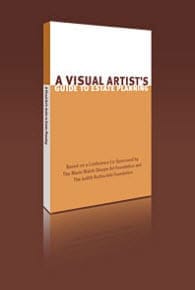Legacy Planning And Consulting
Barbara T. Hoffman’s legal skills and expertise are particularly useful to the planning of the visual artist, and other creatives’ estates. Her expertise in foundation law and not-for-profit governance are a useful asset to creatives and visual artists who wish to set up artist endowed foundations during lifetime of the management of governance of such foundations and charitable trusts after the artist has died. Her knowledge of intellectual property and copyright is a particular asset in working with writers, visual artists and other creatives while her knowledge of architecture and work with architects is a niche interest and specialty.

Barbara T. Hoffman has decades of experience advising and managing artists’ estates as well as working with living artists at all stages of their careers in planning and realizing a legacy. She has provided the legal structures for numerous artist’s endowed foundations and serves on the board of several of such foundations.
The Hoffman Law Firm consults on the catalogue raisonné and the donations of archives, as well as provides advice and legal services related to exhibitions, loans to museums, sales to auctions, other art market advice including identification of galleries, grant making programs for the foundation, and copyright management.
A Visual Artist’s Guide to Estate Planning: The 2008 Supplement Update
The Artist’s Estate: Structuring And Managing An Artist’s Legacy
Estate planning involves more than drafting a will; building and preserving a legacy involves a variety of skills. While the artist is alive, building a legacy is a collaboration between the artist and his or her advisor. After the artist’s death, a variety of skills and a supportive team can continue the artist’s strategic vision.
Two of the most difficult decisions for many artists is who will be in charge of managing the artist’s legacy and the artistic assets left behind and who or what is the beneficiary of the estate’s assets: a foundation, a trust or heirs.
As the artist Betty Woodman noted, “It seems there are two things to be concerned about: the well-being of the person to whom you give the property and the well-being of the property (art).” Many artists are concerned that the family member may not be interested in developing the artist’s legacy, or may not be competent to do so, or would be unduly burdened by the obligations imposed upon them to probate and/or manage an artist’s estate. For that reason, the largely anecdotal article by Robin Pogrebin in The New York Times entitled, “Decision Time for Aging Artists” on January 31, 2017, seems to miss the forest for the trees.
For those charged with structuring and managing an artist legacy, the most difficult choice is not necessarily whether to choose an auction house or gallery to represent the estate. The most difficult choice is who will be named in the will if there is one, or by the court if there is not, to collect and sell the estate’s assets, pay the estate’s debts and collect any money owed to the estate and administer and manage the artist’s legacy, including his or her art, intellectual property, and personal archive.
This is the executor. In addition to these various functions, the executor follows the artist’s instructions in the will which may include creating a foundation, selling works at auction, or entering into relations with a gallery.
Choosing The Right Executor
The fundamental duty of the executor is loyalty to the beneficiaries of the estate, or as Peter Stevens, executive director of the estate of David Smith noted, “Choose someone with the most expertise and the least amount of self-interest.”
A Visual Artist’s Guide to Estate Planning states, “Above all, make your executor and any advisors aware of your priorities; choose people who are knowledgeable about the art world and sympathetic to your work, and encourage them to seek advice from other experts whenever necessary.”
A competent and trusted family member should be named as the executor or executrix (the feminine) unless the person has expressed a desire not to be placed in this role or because the person is not competent either by temperament or mental state to be in charge of the artist’s estate.
All too often there is a tendency to look to an artist’s trusted professional advisors, the artist’s gallery, the artist’s accountant, or the artist’s lawyer to serve in the role of executor. Absent very specific factors and conditions, such as long-term professional relationships and the lack of any reliable family member to list a few, a family member should be preferred to these professionals. That family member can then hire competent professionals and advisors, including the artist’s gallery.
It is at this point where it becomes important to evaluate any long-term artist-gallery relationships, the capacity and commitment of the gallery to working and developing the artist legacy, or the prior long-term relationship held with the gallery.
As auction houses are presently constituted, with their focus primarily on sales of works of art consigned to them by collectors, and for auction or private sales, would not be a first choice to manage an artist’s estate or as the beneficiary of the artist’s assets. Notwithstanding Sotheby’s Amy Cappellazzo’s claim: “We’re not an auction house […] We’re an art business,” whether an auction house can transform its culture into the “care and feeding” of artist’s estates remains a question.
Galleries, unlike auction houses, do more than sell works of art: Galleries, particularly those who have long-term relationships with older artists, committed to an artist’s legacy, may undertake catalogue raisonné; organize exhibitions in the gallery and with museums; prepare publications and archives; and have a strategy which may include buy in of artist’s works at auction.
Who Will Benefit From The Assets?
A second major concern for artists is setting priorities as to who will benefit from the assets of the estate. For the artist whose primary mission is to preserve and create a legacy either solely benefiting the artist and his or her professional reputation or the artist’s reputation and his or her philanthropic goals, the “artist endowed foundation” may be the vehicle of choice.
Such foundation may be a private foundation or a private operating foundation. The foundation must be funded with sufficient assets to fulfil its mission and unless a board of directors dedicates enormous sweat equity, for example the estate of Ree Morton or the Dorothy Dehner Foundation, less than two million dollars in assets may prove an obstacle.
The difficult choices posed by Ms. Pogrebin are left to the expertise of trustees or directors who are often familiar with the art world and its players. These individuals advise on or hire others to advise on catalogue raisonnés, auction sales, and appraisers. Control, however, rests with those most identified with the artist’s interests.
Addressing Conflicts Of Interest
Transactions with both galleries and auction houses that are involved in direct management of estate or foundation assets pose numerous conflict of interest issues which require transparency and oversight. Unlike the conflict of issues which may be raised by direct involvement of a gallery or auction house as the executor, a gallery or auction house may not be absolutely prohibited under state conflict of interest rules from participating. See “The Many Facets of Conflict of Interest” in Ethics and the Visual Arts..
Every artist, however, has an estate plan-either one imposed if the artist dies without a will or one of his or her own careful deliberation and planning. For artists whose oeuvre may not support a foundation or who simply do not wish to create one, the Artist Legacy Project offers a solution, if the artist is accepted.
Legacy artists are painters and sculptors whose estates have been accepted by Artists’ Legacy Foundation’s (ALF) board of directors and entrusted by the artist or artist’s heirs to the Artists’ Legacy Foundation in perpetuity.
For example, since receiving founder Viola Frey’s bequest, the Artists’ Legacy Foundation has enhanced her legacy by supporting and promoting the exhibitions at museums and galleries. The website states,
“Beyond facilitating museum and gallery exhibitions, the Foundation organizes, stores, conserves, and insures all of Frey’s artwork and is creating a working database to make information about her artwork readily accessible; ALF has commenced a long-term project to produce the Frey catalogue raisonné and is organizing the artist’s papers and other archival materials to make them available and accessible to researchers, scholars, and students.”
Creating A Living Legacy For The Visual Artist
Increasingly, financially successful visual artists have turned to creating a living legacy. Docimenta 2022, focused on artists whose principal art practice was community based. Visual artists like Titus Kafir, Derrick Adamans, Eric Fischel and April Gornik, have made a public charity or tax exempt private operating foundations as part of their artistic practice. The mission of these foundations is to generate and revitalize their local communities through the arts and community based activities, which may include artist residencies. Hoffman’s knowledge of setting up foundations and expertise in board and not-or-profit governance is particularly useful in guiding the artist who wishes to set up a charitable foundation.
Get Help With The Strategic Development Of An Art Collectors’ Legacy
With her profound knowledge of the art world and an incredible network worldwide, Barbara T. Hoffman is in high demand and has advised private collectors, foundations and museums in creating strategies for dispersing art collections, either marketing and sales, auctions, or the setting up of private foundations and private museums.
She has had a particular expertise in developing sculpture parks and collections. As part of her commitment to her clients’ legacy objectives, she has helped in the selection of galleries, appropriate auction houses, and other venues for the exhibition, sale, and display of collections.
Call 212-873-6200 or email our New York City office to talk with attorney Barbara T. Hoffman about your unique situation.


